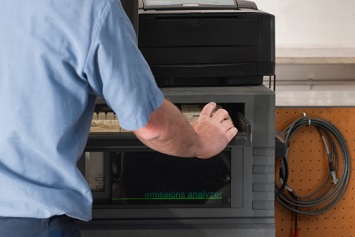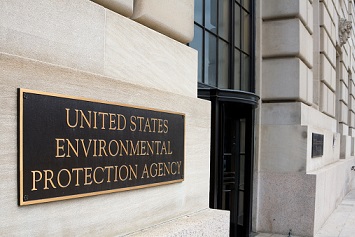Volkswagen’s (VW) successful efforts to cheat the EPA’s emissions testing of light-duty vehicles with defeat devices became major public news in 2014 and continues to have repercussions today for those offices within the Agency that conduct vehicle testing and oversee compliance.
Most significantly, the EPA’s Testing and Advanced Technology Division (TATD) has instituted what it calls special testing, a package of technologies designed to uncover illegal defeat devices (formally unapproved Auxiliary Emission Control Devices (AECDs)) of the type the Agency failed to detect when it lab-tested Volkswagens’ vehicles. Essentially, special testing involves more accurately duplicating real-world on-road driving in contrast to what can be achieved in the standard dynamometer tests that failed to detect Volkswagen’s deception.
Also, as reported in May 2018 by the Agency’s Office of Inspector General (OIG), the Agency’s Office of Air and Radiation (OAR) has agreed to undertake internal administrative actions to address “opportunities for improvement” identified by the OIG for the light-duty vehicle testing and compliance program.
The U.S. case against VW resulted in $4.3 billion in civil and criminal penalties and the indictment of company executives and employees for their roles in the case. The size of the case and the publicity it attracted educated the general public for the first time about vehicle defeat devices. But while the use of such devices is far from the most common environmental violation, neither is it rare. Before the VW case, the EPA initiated enforcement six times after discovering the use of illegal devices in light-duty vehicles (1973, 1974, 1995, twice in 1998, and 2003). Also, in 2017, 3 years after the Volkswagen scandal broke, the Agency initiated enforcement against another automaker for defeat devices discovered through the improved screening afforded by special testing.
It remains to be seen if the Agency’s special testing and enhanced internal controls will discourage future inclinations automakers may have to conceal emission-control defeat devices in their products to improve vehicle performance and sales. As pointed out by the OIG, the Agency’s “light-duty vehicle compliance staff” has ranged in numbers from 31 to 41 between 2012 and 2016. Compare this to the nearly 1 million workers employed in U.S. auto manufacturing and about twice that number working in the auto retail sector. That comparison may suggest to outside observers that the EPA cannot possibly detect sophisticated defeat devices and still meet its obligation to approve in a timely manner the Certificates of Conformity (COC) automakers must obtain from the Agency to sell their cars in the United States. (Currently, there are about 245 million light-duty vehicles in use in the United States, which have been approved for sale by about 800 COCs). But, as the VW case highlights with blazing clarity, the consequences of getting caught for cheating can be extraordinary.
Background
The Clean Air Act (CAA) directs the EPA to establish regulations that set limits on emissions of nitrogen oxide, carbon monoxide, and other pollutants from cars, trucks, and other mobile sources of air pollution. One set of regulations apply to light-duty vehicles—that is, cars and trucks weighing up to 14,000 pounds. Under the regulations, manufacturers must submit COC applications for a specific test group for EPA review. The COC application must include information that demonstrates compliance with emissions standards under all standard test cycles (for example, engine start-up, urban driving, and highway driving). The COC application must include information on AECDs. These devices are allowable under certain circumstances (for example, if the AECD is needed to safely operate emergency vehicles). The EPA conducts testing to determine if the emissions data in the COC application are accurate. Any nondisclosure of an AECD is a CAA violation.
In 2014, the International Council on Clean Transportation commissioned a study by West Virginia University’s Center for Alternative Fuels Engines and Emissions. The study initially alerted the EPA to VW’s potential noncompliance. In September 2015, the EPA alleged that VW had installed software that kept the emission control equipment functioning properly during the standard test cycles but turned off the controls during real-world operation. The software allowed VW’s vehicles to emit up to 40 times the pollution limit during normal operation while appearing to pass the standard test cycles.
Once uncovered, the scale of VW’s deception proved extraordinary. In the United States alone, about 48,000 Volkswagen and Audi models were affected by the defeat software. Worldwide, the software was used in an estimated 11 million vehicles involving several VW lines.
California, which develops and enforces its own vehicle emissions standards, was also victimized by VW and has subsequently worked in parallel with the EPA in taking enforcement action against the company.

EPA Responds
After announcing the allegations against VW, the EPA told manufacturers that it would include special testing or additional defeat device screening protocols in its compliance oversight programs. As noted, these new screening protocols have resulted in the EPA identifying noncompliance and the use of defeat devices by at least one other manufacturer.
In its report, the OIG states that it reviewed the enhanced measures the EPA is now using to audit new and in-use vehicles.
“Special testing screens vehicles for defeat devices by using random/off-cycle testing, which can be variations of the standard test cycles, or new test cycles,” states the OIG. “Special testing helps screen for AECDs that may be acting as defeat devices. More specifically, special testing can identify defeat devices that detect when a vehicle is being tested under standard test cycles and can thus detect whether emission control systems are being altered, as was done in the 2015 VW case. Special testing also includes the use of Portable Emissions Monitoring Systems to measure on-road emissions and more effectively screen for defeat devices. Portable emissions monitoring system testing has identified noncompliance and the use of defeat devices by other manufacturers.”
External experts the OIG interviewed confirmed that “special testing is the key control activity needed to address the risk of defeat devices.” The OIG says it also confirmed that the EPA’s use of special testing and portable emissions monitoring have increased.
Recommendations Accepted
The OIG concluded that the EPA’s light-duty vehicle compliance program “has demonstrated that its current internal controls are effective at detecting and preventing noncompliance—a precursor to potential fraud.” But the OIG also identified areas where these controls could be further strengthened to help the Agency “better address strategic risks and achieve compliance with mobile source regulations.”
Following are the OIG’s recommendations, the OAR’s responses, and the anticipated completion dates.
- Recommendation 1: Define measures to assess the performance of the EPA’s light-duty vehicle compliance program.
Response: The OAR agreed. The OAR currently uses in-use vehicle emissions testing data to track light-duty emissions compliance. The OAR said it will develop additional performance measures to better monitor emissions compliance and program success.
Planned completion date: The recommendation will be implemented in four phases: (1) Develop the performance measures by the end of quarter (Q)2, fiscal year (FY)2019; (2) implement, gather data, and evaluate at the end of Q2, FY2020; (3) revise measures as informed by evaluation, then fully implement measures at the end of Q2, FY2021; and (4) use those measures to inform program management moving forward, a step that is ongoing. - Recommendation 2: Conduct and document a formal risk assessment for the EPA’s light-duty vehicle compliance program that prioritizes risk and links specific control activities to specific risks. Update the risk assessment on a scheduled and periodic basis.
Response: The OAR agreed. The OAR currently conducts an informal risk assessment of its light-duty vehicle compliance program but says it will expand and formalize this process and develop protocols for implementation and documentation.
Planned completion date: End of Q1, FY2020. - Recommendation 3: Develop internal procedures or guidance on how special testing should be incorporated into certification, production, and in-use testing programs to formalize the role of special testing in the EPA’s light-duty vehicle compliance program.
Response: The OAR agreed and said it recognized that it is important to have a formal process in place to memorialize the use of special testing in the light-duty vehicle compliance test programs. “Currently, the use of special testing is a crucial component of compliance oversight and a priority that enjoys strong support from OTAQ [Office of Transportation and Air Quality] management and a knowledgeable and experienced light-duty team,” said the OAR. “OAR will need to determine how best to document the use of procedures for special testing and other programs that are non-standard by definition.”
Planned completion date: The OAR’s OTAQ anticipates that by Q3, FY2019, it will complete a document that describes how special testing will be integrated into the EPA’s compliance oversight activities. - Recommendation 4: Formally track light-duty vehicle compliance issues, including how issues were identified, the current status of these issues, and the enforcement actions taken.
Response: The OAR agreed and said it recognized the importance of tracking compliance. Currently, the OTAQ tracks issues informally but does not maintain a standard tracking format. The OAR said it will develop a system for tracking various compliance issues, such as certification, in-use, and regulatory implementation, and identify how the issues are resolved. The OAR said it will also track the compliance issues it submits to the EPA’s Office of Enforcement and Compliance Assurance (OECA) for possible enforcement action.
Planned completion date: End of Q1, FY2019. - Recommendation 5: Enhance information and communication controls by creating regular, standardized reports from state inspection/maintenance, remote sensing, and other data sources to help identify potential compliance issues.
Response: The OAR agreed “with the understanding that the intent is to facilitate and optimize use of data sources that are available to EPA.” The OAR said it will establish standard and trackable mechanisms for regular collaboration and information exchange among OTAQ divisions. “The objective will be to routinely share and discuss external data to facilitate their use in both risk assessment and ongoing compliance oversight,” said the OAR. “For example, OTAQ will hold quarterly meetings to review information that may help identify potential compliance issues.”
Planned Completion Date: The OAR told the OIG that the first meeting was scheduled for April 24, 2018. - Recommendation 6: Assess the necessity of e-mail in-boxes that the OTAQ maintains for feedback, delete unnecessary in-boxes, and update websites as necessary.
Response: The OAR agreed and said it recognized the importance of providing convenient and timely responses to the public and industry.
Planned completion date: Complete. - Recommendation 7: Develop protocols for sharing information with the California Air Resources Board (CARB) to facilitate sharing of emissions testing and other information for compliance assurance and enforcement purposes.
Response: The OAR agreed and said it will work with CARB to, first, create and exchange documents to formalize the current understanding of how certification and compliance information is shared and, second, create and disseminate training materials and guidance for staff that clearly articulate the types of information that will be shared and the circumstances under which information sharing will occur.
Planned completion date: First action by the end of Q2, FY2019; second action by the end of FY2019.
The OIG’s report is at https://www.epa.gov/sites/production/files/2018-05/documents/_epaoig_20180515-18-p-0181.pdf.


